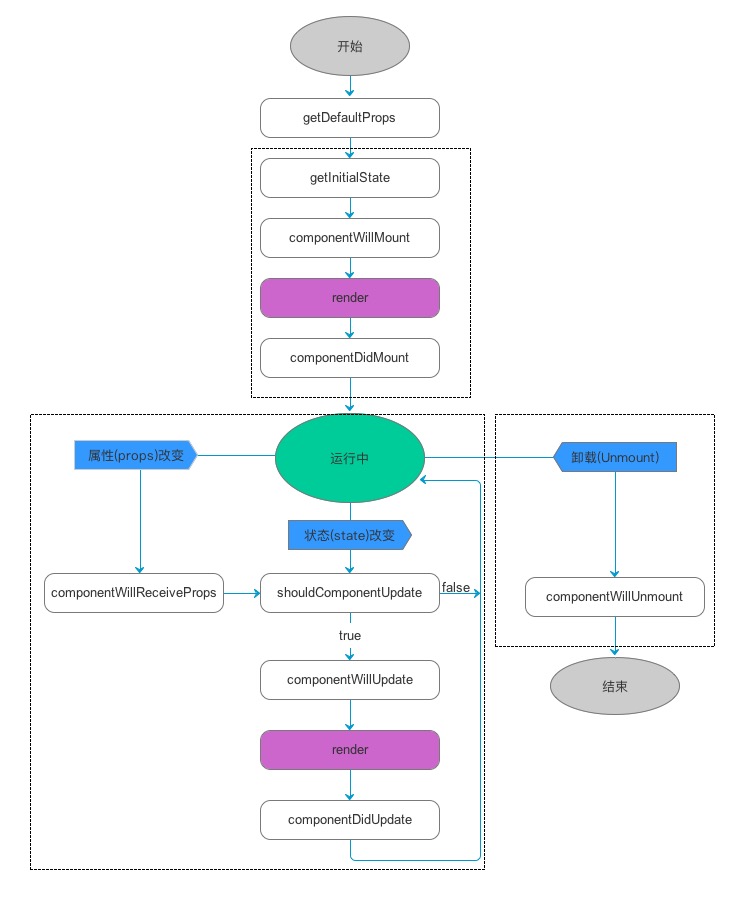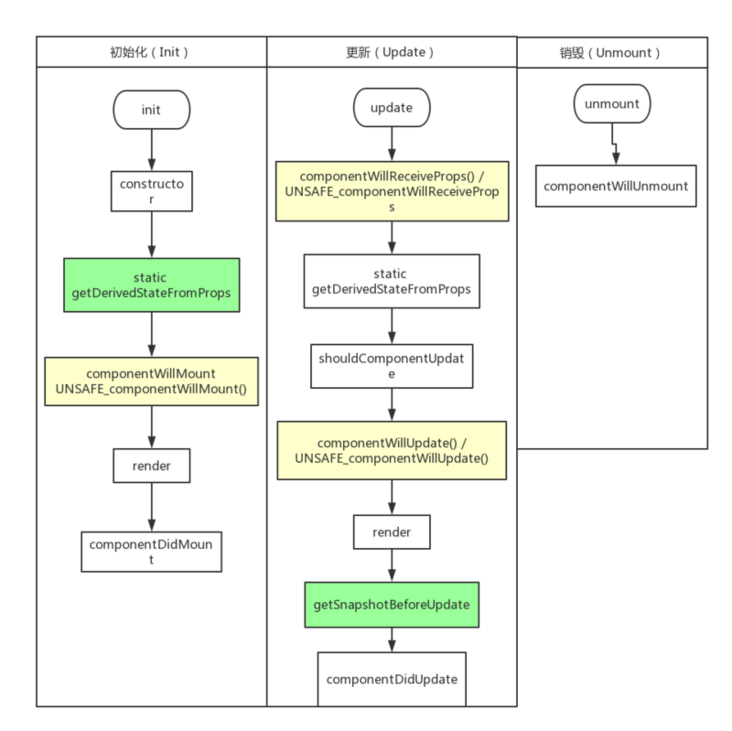在本章节中我们将讨论 React 组件的生命周期。
react v16.3版本以下的生命周期,如下图:

react v16.3版本及以上的生命周期去掉了以下三个
componentWillMount
componentWillReceiveProps
componentWillUpdate
同时为了弥补失去上面三个周期的不足又加了两个
static getDerivedStateFromProps
getSnapshotBeforeUpdate
如下图:

组件的生命周期可分成三个状态:
- Mounting:已插入真实 DOM
- Updating:正在被重新渲染
- Unmounting:已移出真实 DOM
生命周期的方法有:
- componentWillMount 在渲染前调用,在客户端也在服务端(v16.3之后失效)。
- componentDidMount : 在第一次渲染后调用,只在客户端。之后组件已经生成了对应的DOM结构,可以通过this.getDOMNode()来进行访问。 如果你想和其他JavaScript框架一起使用,可以在这个方法中调用setTimeout, setInterval或者发送AJAX请求等操作(防止异步操作阻塞UI)。
- componentWillReceiveProps 在组件接收到一个新的 prop (更新后)时被调用。这个方法在初始化render时不会被调用(v16.3之后失效)。
- shouldComponentUpdate 返回一个布尔值。在组件接收到新的props或者state时被调用。在初始化时或者使用forceUpdate时不被调用。
可以在你确认不需要更新组件时使用。 - componentWillUpdate在组件接收到新的props或者state但还没有render时被调用。在初始化时不会被调用(v16.3之后失效)。
- componentDidUpdate 在组件完成更新后立即调用。在初始化时不会被调用。
- componentWillUnmount在组件从 DOM 中移除之前立刻被调用。
- static getDerivedStateFromProps 该函数在一个组件被实例化或者接受到新的 props 的时候被触发。它返回一个对象,该对象可用来更新 state。该函数与 componentDidMount 一起使用可以取代 componentWillReceiveProps的所有功能。
- getSnapshotBeforeUpdate 该函数在任何变化(例如 DOM 更新)发生之前被触发。返回值被传给 componentDidUpdate。该函数与 componentDidUpdate 一起使用可以取代 componentWillUpdate 的所有功能
这些方法的详细说明,可以参考官方文档。
以下实例在 Hello 组件加载以后,通过 componentDidMount 方法设置一个定时器,每隔100毫秒重新设置组件的透明度,并重新渲染:
React 实例
class Hello extends React.Component {
constructor(props) {
super(props);
this.state = {opacity: 1.0};
}
componentDidMount() {
this.timer = setInterval(function () {
var opacity = this.state.opacity;
opacity -= .05;
if (opacity < 0.1) {
opacity = 1.0;
}
this.setState({
opacity: opacity
});
}.bind(this), 100);
}
render () {
return (
<div style={{opacity: this.state.opacity}}>
Hello {this.props.name}
</div>
);
}
}
ReactDOM.render(
<Hello name="world"/>,
document.body
);以下实例初始化 state , setNewnumber 用于更新 state。所有生命周期在 Content 组件中。
React 实例
class Button extends React.Component {
constructor(props) {
super(props);
this.state = {data: 0};
this.setNewNumber = this.setNewNumber.bind(this);
}
setNewNumber() {
this.setState({data: this.state.data + 1})
}
render() {
return (
<div>
<button onClick = {this.setNewNumber}>INCREMENT</button>
<Content myNumber = {this.state.data}></Content>
</div>
);
}
}
class Content extends React.Component {
componentWillMount() {
console.log('Component WILL MOUNT!')
}
componentDidMount() {
console.log('Component DID MOUNT!')
}
componentWillReceiveProps(newProps) {
console.log('Component WILL RECEIVE PROPS!')
}
shouldComponentUpdate(newProps, newState) {
return true;
}
componentWillUpdate(nextProps, nextState) {
console.log('Component WILL UPDATE!');
}
componentDidUpdate(prevProps, prevState) {
console.log('Component DID UPDATE!')
}
componentWillUnmount() {
console.log('Component WILL UNMOUNT!')
}
render() {
return (
<div>
<h3>{this.props.myNumber}</h3>
</div>
);
}
}
ReactDOM.render(
<div>
<Button />
</div>,
document.getElementById('example')
);
 自学教程
自学教程